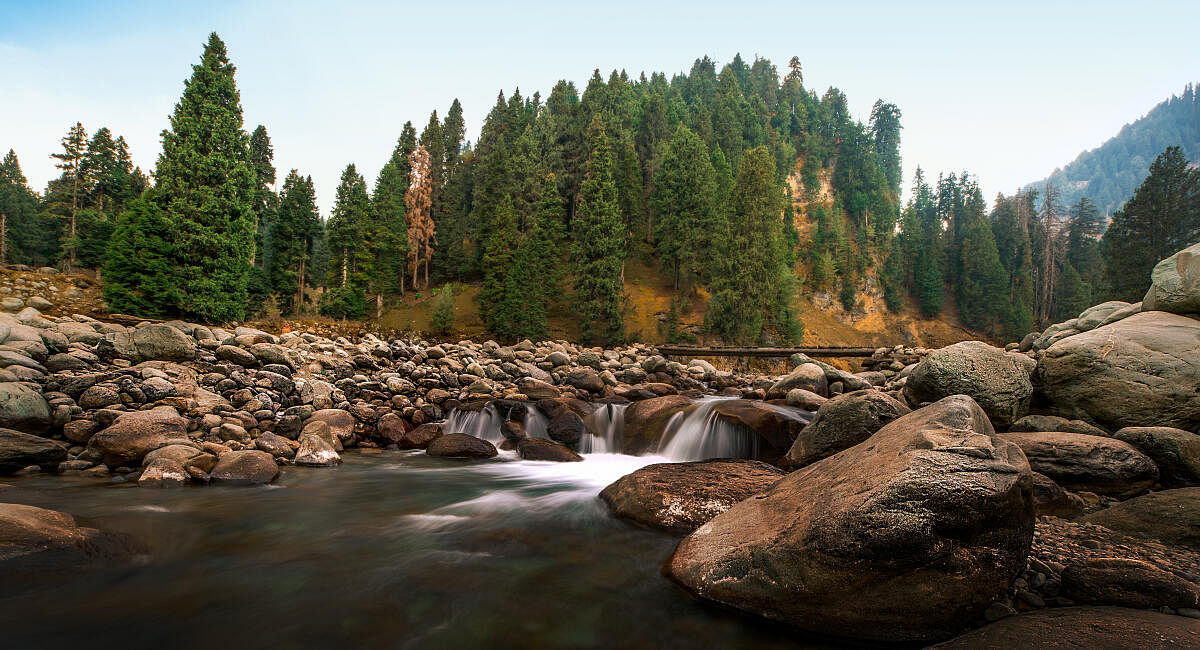

The road suddenly became steep after Budgam town. The bends in the road are more angled; the ride gets a tad edgy. We had started from Srinagar and were on our way to Doodhpathri. We had driven past apple orchards, apples still tiny and raw; still a few months to go before the plucking season. Just before the entrance to the central part of Doodhpathri, we could see colourful umbrellas swaying in the breeze, and below each, a tea vendor selling noon chai (Kashmiri salted pink tea). Picnickers were busy taking selfies while their teachers sprawled on the durries spread on the grassy earth, gossiping while sipping their tea. We have a quick stop over tea with makke ki roti, carrot and nadru (lotus stem) pickle.
We drive ahead, and my eyes fall on a gigantic picture postcard just after a bend. Acres and acres of greenery stretched from left to right as far as I could see. Lush green meadow and without a soul in sight. And this against a backdrop of rows of tall, dark green pine and deodar trees. Behind that, lie the folds of the majestic Pir Panjal Mountain range with some of its peaks covered in snow. I sit on one of the benches so thoughtfully provided on the periphery of the meadows.
I gaze at the distant peaks and the clouds above it, feeling like a performer on this grand stage created by God. Kicking off my shoes, I start walking, aimlessly, but pleased with the feel of the cool grass beneath my feet. Suddenly to the distant right, I see a white mass moving very slowly. I do a double-take. Do I see a glacier?
Not really... I then look more carefully. Hundreds of sheep were moving, shepherded by the Gujars, the community of shepherds that have been herding cattle for millennia. They travel to the meadows of Kashmir in the summers and return to their bases in the Jammu area before the onset of winter when these meadows get thickly laden with snow.
How it got its name
There is an intriguing story on how Doodhpathri got its name. Pathri in the Kashmiri language means meadow. Sheikh Nooruddin Noorani, also known as Sheikh ul Alam or Nund Reshi, was a Sufi saint and poet born in the 14th century. Both Muslims and Hindus revere him, and his teachings continue to be a significant influence in Kashmir. The story goes that he once stayed for a few days in Doodhpathri. He wanted water for ablutions before his prayers. He struck his staff on the ground and out gushed milk. He exclaimed, “I cannot use milk for my ablutions; what I need is water.” The milk (doodh) immediately turned into water, but the name Doodhpathri stuck. There is possibly another story behind the name, but more about it later.
We drive further ahead past the squat mud and wood huts of the shepherds. More locals are having their picnics along the way, and some enjoy pony rides. What would hill stations be without the ubiquitous ponies and the extortionist pony wallahs!
Time to park the car; it cannot go any further. I walk into The Grand Ghazi Café whose name board proudly announces its parentage “Under Doodhpathri Development Authority” in big and bold, perhaps reassuring customers of the quality of the offerings.
When rocks turned into milk...
Shaliganga River cascades down, colliding against rocks — big and small — along the way. I walk across to the river, stepping carefully on a rotting wooden log placed along the way. A misstep could cause a fall onto the rocks. The cascading water foams as it hits the rocks turning milky, doodh! This milk-like water could be another reason the area is called Doodhpathri! Tourists are doing what tourists want to do — taking selfies while being perched precariously on the rocks.
Doodhpathri is one of those pristine places which, despite being so close to the tourist hot spot Srinagar (just 45km southwest of Srinagar), just falls off the tourist map.
Tourists land in Srinagar, look around and then move onwards to Gulmarg, Pahalgam and Sonmarg, ending their Kashmir trip. Kashmir has a lot more to offer. Ask those newlyweds atop the rock on Shaliganga River!